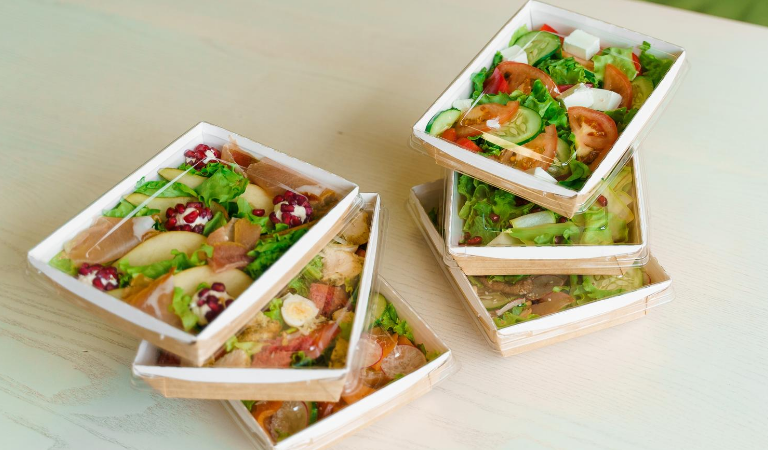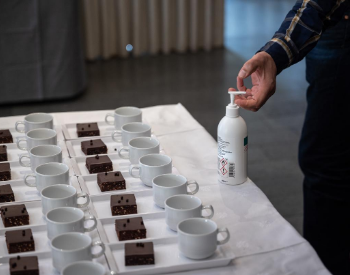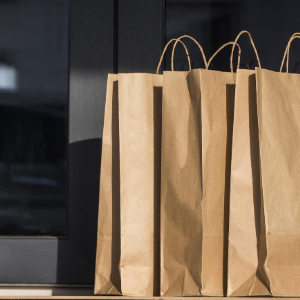Looking ahead towards what the future of the catering industry will look like in a post-pandemic world, there will likely be several lasting changes for serving guests at weddings, luncheons, private events, and other special occasions. In order to get your catering business ready to resume services, it’s important to adapt to the changing practices and trends in the foodservice industry. An emphasis on single-use utensils, individually packaged portions, and enforcing social distancing guidelines will allow guests and employees to feel safe at venues in the future.
Keep in mind that when catering guests are at social gatherings in the near future, it is important to provide them with everything they need to enjoy their meals while reducing the risk of spreading COVID-19 or airborne particles. Restaurant and bar owners have already begun implementing social distancing standards and enforcing sanitation at their establishments, and your catering business should be doing the same.
If you’re wondering how your catering company can adapt to serving guests in a post-COVID-19 world, below
are some helpful tips to help your business keep catered events as safe and sanitary as possible.
How To Assemble Catered Meals
In order to reduce the spread of germs between your employees and guests, preparing meals at catered events will look very different. Chef-attended food stations where skilled chefs once prepared foods for guests on the spot have been eliminated, along with self-serve buffets. The CDC and some state guidelines concerning the catering industry have encouraged arranging foods into individual containers, and completely preparing meals before events to minimize the number of direct contact employees experience while serving guests.
Individually Packaged Appetizers & Desserts
If your client is requesting an appetizer spread or dessert table for their future event, consider assembling foods into individually-packaged containers. Keeping foods in separate containers is a sanitary way to serve guests, as direct contact between employees and guests is eliminated. For each kind of appetizer or dessert you are serving, plate them in containers with lids and arrange them onto tables so guests can choose their meals themselves. Be sure to use food labels or transparent containers so guests can easily identify different options and reduce sorting through various containers.
Boxed Meals
Instead of serving guests delicious entrees at tables, buffets, or food stations, pack up your foods into boxed lunches. Meal kits are an innovative way to provide your clients with their requested dining experience. Get creative and assemble boxed meals into artfully-crafted containers, add handwritten labels, ingredient cards, and other personalized elements. Whether you’re serving breakfast, lunch, or dinner at your events, boxed meals easily fit portions of all different sizes. You can personalize your packaging choices to fit what your business needs. To enforce sanitary practices at catered events and reassure guests, be sure to seal boxed lunches with tamperproof stickers.
Creative Food Presentation
Adapting menus to arrange meals in a unique manner is a great way to attract customers to your catering services. Clients are still looking to make their dining experience memorable for their guests, and plating boxed lunches unconventionally is an easy way to catch the eye of guests at catered events and impress your clients with your company’s services. Take a look at your prepackaged menu items and find ways to elevate your food presentation. Find inspiration from large catered buffets or food stations and create individual charcuterie boards in wooden take out boxes or personalized dessert platters on disposable trays.
How To Safely Serve Guests
Assembling meals and serving guests go hand-in-hand at most catered events, so it’s important your business adjusts serving styles at future events to accommodate new sanitation standards and social distancing guidelines. While having your employees directly serve guests their meals at special occasions is a large part of the catered experience your clients might be looking for, it can increase person-to-person contact and cross-contamination.

Grab-and-Go Stations
The foodservice industry has encouraged catering businesses to make the switch from buffets and self-serve stations to assisted
-serve stations at events and grab-and-go stations at events. Guests can grab their desired meals, appetizers, or desserts without actually handling the food selection. This creates a comfortable and safe catering experience for guests and employees alike since physical contact is drastically lowered.
If your catering service chooses to keep some staff members attending food stations, consider placing clear plexiglass on one side of your food station to minimize any possible contact from guests as they serve themselves. Self-serve stations can aid in keeping events sanitary and safe while streamlining the pace of catered events, as guests can quickly grab their entrees or appetizers and return to their tables.
Limited Lines
For guests at catered galas and weddings, making long lines at several food stations throughout a venue is commonplace. However, in order to properly practice social distancing at catering events in the future, it’s best to limit these lines to a couple of people at a time. Ask guests to wait their turn before walking over to food stations, and be sure that a minimum distance of 6 feet is kept between individuals. Your employees can even place floor stickers near food stations if your event’s venue allows it. In order to streamline serving guests in limited lines, be sure that individual portions are labeled so they can be quickly identified by employees and handed out to guests.
Masks and Gloves
For the health and safety of guests at your catered events, it’s incredibly important to encourage employees to wear masks and gloves. Servers who might be directly interacting with guests will benefit from using masks and gloves to lower the spread of airborne germs and viruses. If possible, provide your employees with masks and other personal protective equipment before they begin working. Be sure to keep sanitizers and antibacterial wipes handy for employees and guests to use during events as well.
Host Live-Virtual Events

If you’re still searching for ways to adapt your catering business to social distancing and COVID-19 regulations, live-virtual events are the perfect way to bring catered events right to your client’s doorsteps. Many companies or organizations have had to postpone their upcoming events this year and might still be wary of hosting a physical gathering. Several companies have chosen to conduct large gatherings online, but that doesn’t mean your business can’t offer catering services to clients hosting online events.
Consider creating a ‘live-virtual’ catering package that offers at-home food delivery to guests, so they can still enjoy meals during their digital meetings. Catering live-virtual events is also ideal for couples celebrating their weddings at home, or for those celebrating special occasions at home. By providing a fine-dining catered experience for clients at their doorsteps, it can help make their celebrations a memorable and safe experience for all.
Prepare For Catering Events In The Future
While the food and beverage industry continues to experience the daily effects COVID-19 brings, it’s now more important than ever to look towards a future in a post-pandemic world. Getting your catering business prepared for the upcoming changes and adjustments to dining experiences will make the transition easy for you and your employees. Consider the options that best fit both your business and clients’ needs to find what works to keep catering services as clean and sanitary as possible. As clients begin to plan upcoming events and social gatherings, they’ll value the steps your company has already set in place to provide a comfortable and special catering experience.








